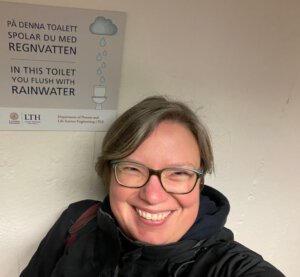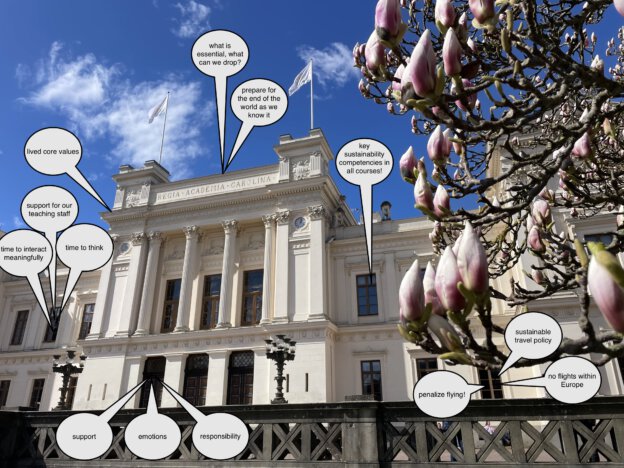This morning, I read the article “Carving space to learn for sustainable futures: A theory-informed adult education approach to teaching” by Holmqvist & Millenberg (2024) and it really resonated with me. They write that “education for sustainability is, by necessity, value-based, place-embedded and emancipatory, seeking to help learners develop a desire to connect – to ‘actively’ be in the world and shape it” and then present a “seed package” in which they propose an activity “meant to help learners realise or gauge the responsibilities and freedoms that we have as persons in the world”.
I love everything about this article. The thoughtful approach to the project and the way it is being reported on, the activity presented in the seed package, and the way it is presented: In a one-page table with the description of the suggested activity in one column and the theoretical background in the other.
In a nutshell, the activity consists of a reflexive walk as individual work and then a collective reimagining of a sustainable world.
The reflexive walk is prepared by some type of input (reading, podcast, video) on a sustainability topic of the individual student’s choice (to let everybody find something that is meaningful to them personally), and it is then done individually in the students’ home environments. This walk has several elements of my “active lunch breaks“: the prompting of a topic of interest, then the “random walk” (in my case) or as they write, the “wandering in a place rather than through it”, and documenting it by taking pictures.
The second step, then, students meet and, in small groups, share the pictures they took and the meaning behind them. So far, so similar to the active lunch break, but then this gets a lot more exciting: Students pick one of their own pictures each, and develop a vision of what that place could be like. They then “intervene” in that image by electronically or physically pasting icons, drawing in it, etc, to develop it into what it could (and should?) be, and share in the same small groups as before. I love this last bit, and it feels so powerful to me to take reality, dream up what it should be like and intervene — even if only virtually or on paper.
And I love how this whole activity is grounded in literature and theory, but at the same time written in such an engaging and approachable way. I actually just sent it to the Editor in Chief of the Nordic Journal in STEM Education as an example of the kind of articles I would love to read there (not quite as revolutionary as it might sound, since I am on the editorial board there myself), and to a bunch of colleagues who I thought would be excited to read it (and they were!). And I included it in a shared slide show for our Teaching for Sustainability initiative. And now I really want to try it myself!
As always in teaching and learning, it becomes really interesting when adapting something to your own context. For example, by thinking about the prompting in the beginning: This could of course be tied closely to the disciplinary content of a course (e.g. how could these buildings be repurposed for energy efficiency, or better social interactions; or how could make better use of rainwater on campus*) or, of course, kept intentionally as wide as in the article. And the activity could be used in the beginning of the course, where students later have the opportunity to continue working with their visions. Depending on the course, they could build prototypes, investigate the legal situation to do a feasibility study, do interviews to find out whether other people would buy into their vision, … Since the walk can be done anywhere and everywhere, the activity is also really virtual- or hybrid course friendly (although, if the meeting later is virtual, maybe even more attention needs to be paid to building trusting relationships between students).
I am especially curious about exploring how to use this in my own academic development workshops. I use the “active lunch breaks” quite regularly (and still get a little stressed out about whether they will really have done it, right before participants get back. But they always do!), and I really want to add the sustainability spin next time. Maybe the prompting then can be that participants should be thinking about their own teaching for sustainability — what do they find on campus that is relevant either because of the discipline they are teaching (see above — for example related to climate impacts), or because of the methods they want to use (so, for example, how can teaching rooms be reimagined, or outdoor spaces be used, or teaching carried out of lecture theatres into the environment students are in during their breaks or on their commute, or other stakeholders than students be included), or because of the key competencies they want to address? And I will definitely not forget to include the “intervention” step and sharing of thoughts on that in the end!
I am really happy I found this article, and on a day where Lund University was ranked 3rd in the world on QS Sustainability Ranking, it is important as ever to find ways to engage students, teachers, our communities, people that are not yet in our communities, in conversations about sustainability. And I think this activity can contribute to that in a really meaningful way.

*this idea being on my mind because, after unsuccessful expeditions trying to find Lund University’s new rainwater-flushed toilets, I finally emailed the person in charge today and was given directions and wished “Happy Flushing!”! So on our own lunch break today, we went looking for — and found! — the mysterious toilet!
Holmqvist, D., & Millenberg, F. (2024). Carving space to learn for sustainable futures: A theory-informed adult education approach to teaching. European journal for Research on the Education and Learning of Adults, 15(3), 299-315. https://rela.ep.liu.se/article/view/5237/4405
